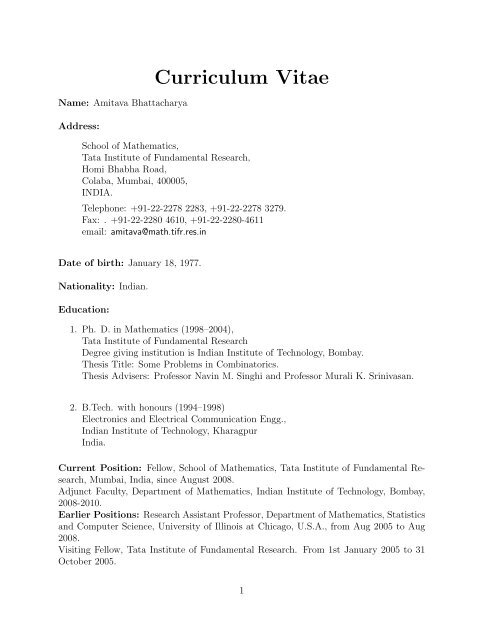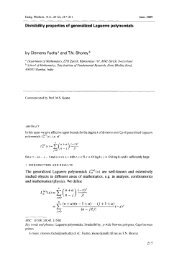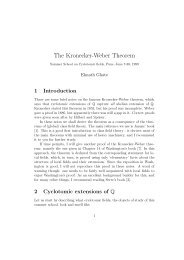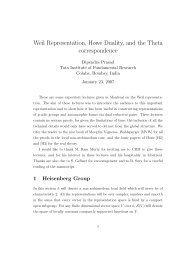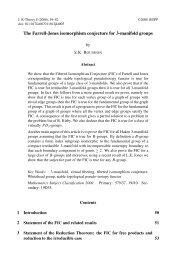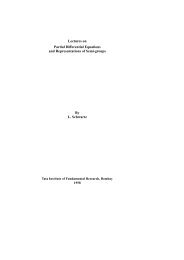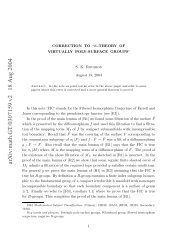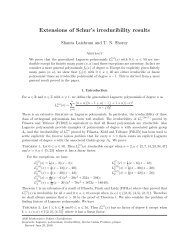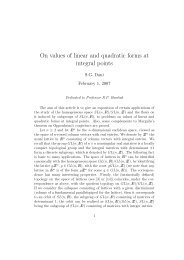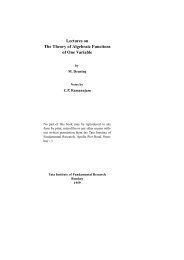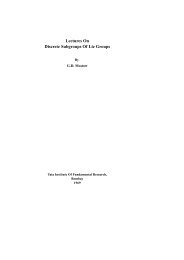Curriculum Vitae - Tata Institute of Fundamental Research
Curriculum Vitae - Tata Institute of Fundamental Research
Curriculum Vitae - Tata Institute of Fundamental Research
You also want an ePaper? Increase the reach of your titles
YUMPU automatically turns print PDFs into web optimized ePapers that Google loves.
Name: Amitava BhattacharyaAddress:<strong>Curriculum</strong> <strong>Vitae</strong>School <strong>of</strong> Mathematics,<strong>Tata</strong> <strong>Institute</strong> <strong>of</strong> <strong>Fundamental</strong> <strong>Research</strong>,Homi Bhabha Road,Colaba, Mumbai, 400005,INDIA.Telephone: +91-22-2278 2283, +91-22-2278 3279.Fax: . +91-22-2280 4610, +91-22-2280-4611email: amitava@math.tifr.res.inDate <strong>of</strong> birth: January 18, 1977.Nationality: Indian.Education:1. Ph. D. in Mathematics (1998–2004),<strong>Tata</strong> <strong>Institute</strong> <strong>of</strong> <strong>Fundamental</strong> <strong>Research</strong>Degree giving institution is Indian <strong>Institute</strong> <strong>of</strong> Technology, Bombay.Thesis Title: Some Problems in Combinatorics.Thesis Advisers: Pr<strong>of</strong>essor Navin M. Singhi and Pr<strong>of</strong>essor Murali K. Srinivasan.2. B.Tech. with honours (1994–1998)Electronics and Electrical Communication Engg.,Indian <strong>Institute</strong> <strong>of</strong> Technology, KharagpurIndia.Current Position: Fellow, School <strong>of</strong> Mathematics, <strong>Tata</strong> <strong>Institute</strong> <strong>of</strong> <strong>Fundamental</strong> <strong>Research</strong>,Mumbai, India, since August 2008.Adjunct Faculty, Department <strong>of</strong> Mathematics, Indian <strong>Institute</strong> <strong>of</strong> Technology, Bombay,2008-2010.Earlier Positions: <strong>Research</strong> Assistant Pr<strong>of</strong>essor, Department <strong>of</strong> Mathematics, Statisticsand Computer Science, University <strong>of</strong> Illinois at Chicago, U.S.A., from Aug 2005 to Aug2008.Visiting Fellow, <strong>Tata</strong> <strong>Institute</strong> <strong>of</strong> <strong>Fundamental</strong> <strong>Research</strong>. From 1st January 2005 to 31October 2005.1
<strong>Research</strong> Interests: Combinatorics, Graph Theory, Convex Polytopes (enumerativeand algorithmic aspects, optimization), Algebraic Combinatorics.Awards:1. Received Kanwal Rekhi Career Development Scholarship in 2002.2. Harish Chandra Award for best thesis dissertation in Mathematics, <strong>Tata</strong> <strong>Institute</strong><strong>of</strong> <strong>Fundamental</strong> <strong>Research</strong>, 2006.Publications[BGS] A. Bhattacharya, S. K. Ghosh and S. Sarkar, Exploring an unknown polygonalenvironment with bounded visibility, Lecture Notes in Computer Science, No. 2073,640-648, Springer Verlag, 2001.[BV] A. Bhattacharya and G. R. Vijayakumar, Effect <strong>of</strong> Edge-subdivision on Vertexdominationin a Graph, Discussiones Mathematicae Graph Theory, 22 (2002) 335-347.[B] A. Bhattacharya, On a conjecture <strong>of</strong> Manickam and Singhi, Discrete Mathematics,272 (2003) 259-261.[Thesis] Ph. D. Thesis, Some problems in combinatorics. (100 pages)[BV] A. Bhattacharya and G. R. Vijayakumar, Domination in digraphs and variants <strong>of</strong>domination in graphs, J. Combin. Inform. System Sci., 30 (2005), no. 1-4, 19–24..[BSS] A. Bhattacharya, S. Sivasubramanian and Murali K. Srinivasan, The polytope <strong>of</strong>degree partitions, The Electronic Journal <strong>of</strong> Combinatorics, Volume 13(1), 2006, 18pages.[Notes] “Quantum Computation, Quantum Error Correcting Codes and Information Theory”.I am the scribe <strong>of</strong> these notes. The lectures were given by Pr<strong>of</strong>essor K. R.Parthasarathy (Indian Statistical <strong>Institute</strong>, Delhi). They have been published by<strong>Tata</strong> <strong>Institute</strong> <strong>of</strong> <strong>Fundamental</strong> <strong>Research</strong> and some <strong>of</strong> the copies have been distributedby AMS. (120 Pages.)[BPS] A. Bhattacharya, U. N. Peled and M. K. Srinivasan, Cones <strong>of</strong> closed alternatingwalks and trails, Linear Algebra and Its Applications, Volume 423, Issues 2-3, 1June 2007, 351–365.[BV] A. Bhattacharya and G. R. Vijayakumar, An integrality theorem <strong>of</strong> root systems,European Journal <strong>of</strong> Combinatorics, Volume 28, Issue 6, August 2007, 1854–1862.[BFP] A. Bhattacharya, U. N. Peled and S. Friedland, The Polytope <strong>of</strong> Dual Degree Partitions,Linear Algebra and Its Applications, Volume 426, Issues 2-3, 15 October 2007,458–461.2
[BFP] A. Bhattacharya, U. N. Peled and S. Friedland, On the First Eigenvalue <strong>of</strong> BipartiteGraphs, The Electronic Journal <strong>of</strong> Combinatorics, Vol. 15, 2008, 23 pages.[BPS1] A. Bhattacharya, U. N. Peled and M. K. Srinivasan, The cone <strong>of</strong> balanced subgraphs,Linear Algebra and its Applications, Volume 431, Issues 12, 1 July 2009, Pages 266-273 Amitava Bhattacharya, Uri N. Peled, Murali K. Srinivasan[BS] A. Bhattacharya and N. M. Singhi, Some Approaches to solve General (t, k) designexistence problem and other related problems, Discrete Applied Mathematics,Volume 161, Issue 9, June 2013, Pages 11801186[BDMT] A. Bhattacharya, B. DasGupta D. Mubayi and G. Turàn, On optimizing HornFormula, ICALP’10 Proceedings <strong>of</strong> the 37th international colloquium conferenceon Automata, languages and programming Pages 438-450 Springer-Verlag Berlin,Heidelberg.Submitted papers[BS] A. Bhattacharya and N. M. Singhi, Characterization <strong>of</strong> line graphs <strong>of</strong> r-uniformhypergraphs with bounded pair degree.[BPS2] A. Bhattacharya, U. N. Peled and M. K. Srinivasan, Alternating Reachability.Statement:I am interested to study basic questions in convex polytopes (enumerative and algorithmicaspects), graph theory and algorithms. I am also interested in algebraic combinatorics.1 <strong>Research</strong> proposal and planned results1.1 Degree sequences <strong>of</strong> r-uniform hypergraphsThe problem to characterize the degree sequence <strong>of</strong> r-uniform hypergraphs is one <strong>of</strong> themost basic unsolved problems in the theory <strong>of</strong> hypergraphs [3]. It is the simplest case <strong>of</strong>the following basic question. Let n, t, k be positive integers such that t < k < n. Let 2f : ( )[n]k → Z≥0 . Let ∂ t f : ( )[n]t → Z≥0 be defined by∑∂ t f(T ) = f(B)for all sets T in ( )[n]t .3T ⊂B,B∈( [n]k )
Problem 1.1 (The general (t, k)-existence problem [31]) Characterize all nonnegativefunctions g : ( )[n]t → Z≥0 such that there exists a function f : ( )[n]k → {0, 1} satisfying∂ t f = g.Some special cases such as t-designs (g constant), partial Steiner systems (g constantand equal to 1), degree sequences <strong>of</strong> r-uniform hypergraphs (t = 1) and some relatedproblems such as f-vectors <strong>of</strong> pure simplicial complexes [20, 22, 17] have received muchattention during the last three decades. Yet we know very little about the problem. Wedo not even know whether or not it is NP-complete.Problem 1.1 is <strong>of</strong> great interest to statisticians since it includes the existence <strong>of</strong> designsas a special case. Statisticians are interested to know if there exists designs with somespecific parameters. It would be <strong>of</strong> immense practical and theoretical value if one couldfind an algorithm (preferably polynomial-time) to solve Problem 1.1.In [31] a simple necessary and sufficient condition is given which solves Problem 1.1 iff takes values in Z. That paper also contains references to earlier work in this direction.In general, Problem 1.1 may not be solvable in polynomial time; in [10] it has beenshown that some problems related to Problem 1.1 are NP-complete; but for many classes<strong>of</strong> designs it may be possible to obtain a polynomial-time algorithm.If we are allowed to repeat edges then the degree sequence problem is easily solvablein polynomial time and there are good characterizations [16, 29]. For graphs this problemis well-studied and there are many elegant characterizations. One <strong>of</strong> the well-knowncharacterizations is due to Erdős-Gallai [13]. The book [24] gives 9 characterizations.For most <strong>of</strong> these characterizations a class <strong>of</strong> graphs called threshold graphs satisfy thecharacterizations in an extremal way. A graph is called threshold if it can be constructedfrom the one-vertex graph by repeatedly adding either an isolated vertex (i.e., a vertexnon-adjacent to all previous vertices) or a dominating vertex (i.e., a vertex adjacent to allprevious vertices). For graphs a polytope associated with the degree sequence problemhas been studied [21, 26, 33] and it yields a good characterization <strong>of</strong> degree sequence <strong>of</strong>graphs. The polytope DS(n) is defined as the convex hull <strong>of</strong> all possible degree sequenceson n vertices. A sequence <strong>of</strong> nonnegative integers is a degree sequence if and only if it liesin DS(n) and its sum is even. The extreme points <strong>of</strong> DS(n) are the degree sequences <strong>of</strong>threshold graphs and vice versa.We attempt to generalize this approach for hypergraphs. This motivates us to defineDS r (n) as the convex hull <strong>of</strong> the degree sequences <strong>of</strong> all r-uniform hypergraphs on nvertices. This polytope has been studied in [4]. That paper showed that the extremepoints <strong>of</strong> DS r (n) are the degree sequences <strong>of</strong> the r-threshold hypergraphs, and that themembership and separation problems for DS r (n) can be solved in polynomial time. Wecan test whether a nonnegative integer sequence is the degree sequence <strong>of</strong> some r-thresholdhypergraph, in polynomial time using the ellipsoidal method. We do not know any otherpolynomial-time characterizations. It seems that it is not sufficient for a nonnegativeinteger sequence to lie in DS r (n) and satisfy some parity conditions in order for it to be thedegree sequence <strong>of</strong> some r-uniform hypergraphs on n vertices. The facets <strong>of</strong> the polytopeDS(n) have been computed [26] and they can be viewed as a “polytope” version <strong>of</strong> the4
Erdős-Gallai inequalities. In contrast, the facets <strong>of</strong> DS r (n) are extremely complicated: ithas facet-defining inequalities with Fibonacci numbers as coefficients. So it seems thatworking with DS r (n) may be hard.To proceed we need a few definitions. A subset I <strong>of</strong> a poset P is called an ideal ifq ∈ I, p ∈ P and p ≤ q imply p ∈ I. We write the elements <strong>of</strong> the set S r (n) = ( )[n]ras increasing sequences (a 1 < a 2 < · · · < a r ), a i ∈ [n] and we partially order S r (n) asfollows: for A = (a 1 , a 2 , . . . , a r ) and B = (b 1 , b 2 , . . . , b r ) in S r (n), A ≤ B means a i ≤ b ifor all i = 1, 2, . . . , r. We use “ideal” also to denote an ideal in S r (n).It is not hard to observe that a nonnegative integer sequence is the degree sequence<strong>of</strong> some r-uniform hypergraph on n vertices if and only if it is majorized by the degreesequence <strong>of</strong> some ideal. This motivates us to consider the problem to characterize thedegree sequences <strong>of</strong> ideals. Some work in this regard has been done in [28].These observations motivated us to consider the order polytope O(P ) <strong>of</strong> a poset P [32],defined byx p ≥ x q , p < q, p, q ∈ P,0 ≤ x p ≤ 1, p ∈ P.Since the constraint matrix <strong>of</strong> this system is totally unimodular, the extreme points<strong>of</strong> O(P ) are precisely the characteristic vectors <strong>of</strong> the ideals <strong>of</strong> P . To optimize linearfunctions over O(P ) we do not need linear programming algorithms such as ellipsoidalmethods or interior point methods; network flows can be used [27].We consider the order polytope O(S r (n)). If x is an extreme point <strong>of</strong> O(S r (n)), then xis the characteristic vector <strong>of</strong> an ideal I <strong>of</strong> S r (n), and by its definition the degree sequence<strong>of</strong> I is non-increasing. This degree sequence is M(n)x, where M(n) is the incidence matrix<strong>of</strong> singletons vs. members <strong>of</strong> ( )[n]r . Thus M(n)O(Sr (n)) is the convex hull <strong>of</strong> all degreesequences <strong>of</strong> ideals.To check whether a given d = (d 1 , d 2 , . . . , d n ) is the degree sequence <strong>of</strong> an ideal, weneed to check whether the equation M(n)x = d has an integral solution x ∈ O(S r (n)), orequivalently whether O(S r (n)) ∩ {x : M(n)x = d} contains an extreme point <strong>of</strong> O(S r (n)).Suppose we are given two polytopes P 1 and P 2 such that P 2 ⊂ P 1 and we ask whetherP 2 contains an extreme point <strong>of</strong> P 1 . This general problem probably does not have apolynomial-time solution, because it is in the class NP and it is not hard to reduce SATto it. In contrast, we believe that our specific problem is tractable since the constraintmatrix <strong>of</strong> O(S r (n)) and M have a nice combinatorial structure, which is not the case forthe corresponding polytope problem for SAT (or other NP-complete problems). So we believeFourier-Motzkin elimination or cutting-plane methods combined with combinatorialtechniques will lead to a polynomial-time recognition <strong>of</strong> the degree sequences <strong>of</strong> ideals.After the degree sequences <strong>of</strong> ideals have been characterized, we want to use a similarapproach to recognize the degree sequences <strong>of</strong> r-uniform hypergraphs. Set P 1 = O(S r (n))and P 2 = {x : x ∈ P 1 and d ≺ Mx}. Then P 2 contains an extreme point <strong>of</strong> P 1 if and onlyif (d 1 , d 2 , . . . , d n ) is the degree sequence <strong>of</strong> an r-uniform hypergraph [8].Before the attempt to study M(n)O(S r (n)), M(n)O(S 2 (n)) was studied. Considerthe following question. Let P be a polytope with integral extreme points in R n that is5
closed under coordinate permutations <strong>of</strong> its points, i.e., x ∈ P implies πx ∈ P , for allpermutations π <strong>of</strong> [n]. For example, DS(n) is such a polytope. Let E denote the set <strong>of</strong>extreme points <strong>of</strong> P , and let E d ⊆ E denote the set <strong>of</strong> extreme points that have nonincreasingcoordinates. There are two natural ways to define the asymmetric part <strong>of</strong> P .In terms <strong>of</strong> lattice points we define the asymmetric part <strong>of</strong> P as the polytopeP d = conv {(x 1 , x 2 , . . . , x n ) ∈ P ∩ N n : x 1 ≥ x 2 ≥ · · · ≥ x n }.In terms <strong>of</strong> linear inequalities we define the asymmetric part <strong>of</strong> P asP l = P ∩ {x ∈ R n : x 1 ≥ x 2 ≥ · · · ≥ x n }.It is easily seen that P d ⊆ P l and E d ⊆ set <strong>of</strong> extreme points <strong>of</strong> P d . Equality need not holdin these two inclusions. In [7] it was shown that for P = DS(n), P d = P l = O(S 2 (n)), andin this case we call this polytope the polytope <strong>of</strong> degree partitions and denote it by DP (n).Because <strong>of</strong> the inequalities x 1 ≥ x 2 ≥ · · · ≥ x n , most <strong>of</strong> the inequalities defining DS(n)become redundant and DP (n) has only polynomially-many facets while still retaining allthe important properties <strong>of</strong> DS(n). It was observed in [7] that DP (n) has 2 n−1 vertices,2 n−2 (2n − 3) edges and (n 2 − 3n + 12)/2 facets. In [7] is was guessed that DP (n) hasp i (n)2 n−1−i faces <strong>of</strong> dimension i, where p i (n) is a polynomial in n. It would be interestingto verify this. It seems that DS(n) is similar to the hypercube in many ways (for thehypercubes we also have P d = P l , and it has 2 n−i facets <strong>of</strong> dimension i).One can ask the same question for DS r (n). Computer experiments suggest that asimilar conclusion may also hold for DS r (n). If this is so then it would be very surprising.Stanley [33] studied a polytope closely related to DS(n). He counted the faces <strong>of</strong> eachdimension for that polytope. In particular he obtained the number <strong>of</strong> distinct degreesequences <strong>of</strong> length n. It would be a good result to do a similar study for DP (n).1.2 Graph theoryConsider a directed graph. Assign a nonnegative real weight to every arc so that at everyvertex, the sum <strong>of</strong> the weights <strong>of</strong> the incoming arcs is equal to the sum <strong>of</strong> the weights <strong>of</strong>the outgoing arcs. The set <strong>of</strong> all such assignments forms a convex polyhedral cone in thearc space, called the cone <strong>of</strong> circulations, which is a basic object <strong>of</strong> study in network flowtheory. For instance, placing integral upper and lower bounds on every arc and askingwhether there is an integral vector in the cone <strong>of</strong> circulations meeting these bounds leadsto H<strong>of</strong>fman’s circulation theorem (see the book [14]). Now consider an undirected analog<strong>of</strong> the situation above. Take a graph whose edges have been colored red and blue. Assigna nonnegative real weight to every edge so that at every vertex, the sum <strong>of</strong> the weights<strong>of</strong> the incident red edges equals the sum <strong>of</strong> the weights <strong>of</strong> the incident blue edges. Theset <strong>of</strong> all such assignments forms a convex polyhedral cone in the edge space, called thealternating cone. The basic theory <strong>of</strong> the alternating cone was studied in [5, 6]. Givena simple graph G(V, E), consider the complete graph on V and color the edges <strong>of</strong> E redand the other edges blue. Then the dimension <strong>of</strong> the alternating cone <strong>of</strong> this 2-colored6
[16] D. Gale, A theorem on flows in networks, Pacific Journal <strong>of</strong> Mathematics 7(1957), 1073–1082.[17] T. Hibi, Algebraic Combinatorics on Convex Polytopes, Carlslaw Publications,1992.[18] A.J. H<strong>of</strong>fman, Some recent applications <strong>of</strong> the theory <strong>of</strong> linear inequalities toextremal combinatorial analysis, Proc. Symp. Appl. Math, 10 (1960), 113–127.[19] F. Jaeger, A Survey <strong>of</strong> the cycle double cover conjecture, Cycles in Graphs, Ann.Discrete Math., 27 (1985), 123–126.[20] G.O.H. Katona: A theorem <strong>of</strong> finite sets, Theory <strong>of</strong> Graphs, P. Erdős and G.Katona, eds., Akademia Kiado and Academic Press (1968), 187–207.[21] M. Koren, Extreme degree sequences <strong>of</strong> simple graphs, J. Combin. Theory Ser.B, 15 (1973), 213–224.[22] J. B. Kruskal, The number <strong>of</strong> simplices in a complex, Mathematical OptimizationTechniques, R. Bellman, ed., University <strong>of</strong> California Press, 1963.[23] L. Lovász and M.D. Plummer, Matching theory, Annals <strong>of</strong> Discrete Mathematics29 (1986).[24] N.V.R. Mahadev and U.N. Peled, Threshold Graphs and Related Topics, Annals<strong>of</strong> Discrete Mathematics 56 (1995), North-Holland, xiv+543 pp.[25] A. W. Marshall and I. Olkin, Inequalities: Theory <strong>of</strong> Majorization and Its Applications.Academic Press, New York-London, 1979.[26] U.N. Peled and M.K. Srinivasan. The polytope <strong>of</strong> degree sequences, Linear Algebraand Its Applications, 114/115 (1989), 349–377.[27] J.C. Picard. Maximal closure <strong>of</strong> a graph and applications to combinatorial problems,Management Science 22 (1975/76), 1268–1272.[28] J. Reiterman, V. Rodl, E. Sinajova and M. Tuma, Threshold hypergraphs, DiscreteMathematics 54 (1985), 193–200.[29] H. J. Ryser, Combinatorial properties <strong>of</strong> matrices <strong>of</strong> zeros and ones, Canad. J.Math. 9 (1957), 371–377.[30] P.D. Seymour, Sums <strong>of</strong> circuits, Graph Theory and Related Topics, J. A. Bondyand U.S.R. Murty, eds., Academic Press, New York (1979), 341–355.[31] N.M. Singhi, Tags on subsets, Discrete Mathematics, R.C. Bose Centennial Symposiumon Discrete Mathmematics and Applications 306(14) (2006), 1610–1623.a – 2
[32] R P. Stanley, Two poset polytopes, Discrete and Computational Geometry, 1(1986), 9–23.[33] R.P. Stanley, A zonotope associated with graphical degree sequences, AppliedGeometry and Discrete Combinatorics, DIMACS Series in Discrete Mathematics4 (1991), 555–570.[34] W.T. Tutte, On the algebraic theory <strong>of</strong> graph coloring, J. Combinatorial Theory1 (1966), 15–50.[35] W.T. Tutte, The method <strong>of</strong> alternating paths, Combinatorica 2(3) (1982), 325–332,.[36] W.T. Tutte, Graph theory, Addison-Wesley, 1984.a – 3


